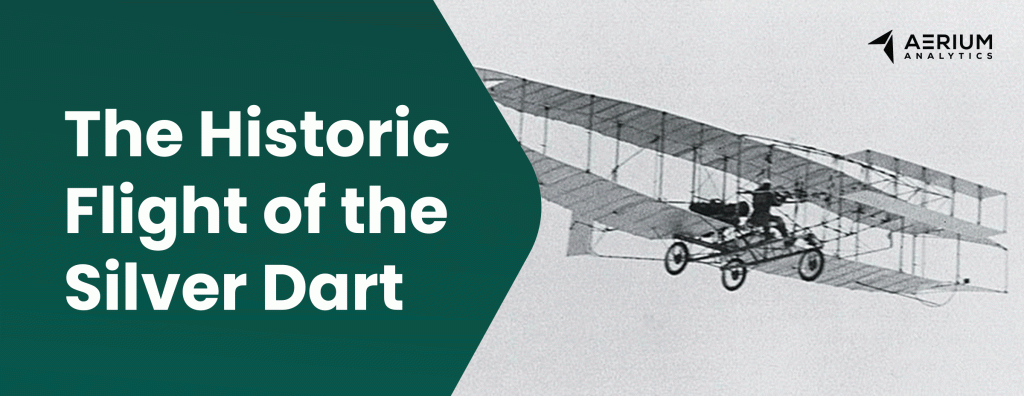
The Historic Flight of the Silver Dart
February 23 marks National Aviation Day in Canada, a time to celebrate how far Canada’s aviation industry has come. It all started in 1909, when the Silver Dart lifted off over Baddeck Bay, making history as the first powered, heavier-than-air flight in Canada and the British Empire. That groundbreaking moment set the stage for a century of progress, shaping the way we travel and innovate today.
The Historic Flight of the Silver Dart
On February 23, 1909, the Silver Dart (The Canadian Encyclopedia. (n.d.). Silver Dart. https://www.thecanadianencyclopedia.ca/en/article/silver-dart) soared over the frozen expanse of Baddeck Bay, marking a defining moment in Canadian history. This remarkable achievement ignited Canada’s aviation industry and set the course for modern air travel.
The Silver Dart was the brainchild of the Aerial Experiment Association (AEA), a research group founded in 1907 by Alexander Graham Bell and funded by his wife, Mabel Bell. Bringing together some of the brightest minds of the time—Canadian engineers J.A.D. McCurdy and Frederick W. “Casey” Baldwin, along with American aviation pioneers Glenn H. Curtiss and Lieutenant Thomas Selfridge—the AEA set out to push the boundaries of flight and revolutionize aeronautical engineering.
Engineering Marvel
The aircraft itself was a marvel of its time, constructed with a lightweight frame of steel tubing, bamboo, and wood. It was covered in silvery balloon cloth, giving rise to its evocative name. At its core was a 50-horsepower, water-cooled V-8 engine, designed by Glenn Curtiss, which allowed the Silver Dart to reach speeds of approximately 65 kilometers per hour. A unique canard configuration, with its elevator positioned at the front, set it apart from other aircraft of the era, reflecting a forward-thinking approach to aerodynamics.
The Historic Flight
On that pivotal winter day, J.A.D. McCurdy took the controls of the Silver Dart. Assisted by local volunteers gliding on skates, the aircraft was positioned on the icy surface of Baddeck Bay. On its second attempt, the Silver Dart gracefully lifted off after a 30-meter run, soaring between 3 to 9 meters in altitude and covering a distance of approximately 800 meters. More than a hundred spectators, including many of Alexander Graham Bell’s neighbors, braved the cold to witness this groundbreaking feat—a moment that heralded a new era in transportation.
Impact and Legacy
The Silver Dart’s successful flight had far-reaching implications for Canada’s aviation future. Over the following months, it completed more than 200 flights, proving its reliability and reinforcing the potential of powered flight. However, during military trials in Petawawa, Ontario, in August 1909, the aircraft sustained irreparable damage upon landing in soft sand, marking the end of its operational history. Despite this setback, its influence endured.
To honor this pioneering achievement, numerous commemorative events took place in 2009 for the flight’s centennial. Former Canadian astronaut Bjarni Tryggvason piloted a meticulously crafted replica of the Silver Dart, paying tribute to its original design. Additionally, Canada Post issued a commemorative stamp, and the Royal Canadian Mint released a special coin, both celebrating the aircraft’s historic significance. (Royal Canadian Mint. (2024). Behind the design: RCAF Centennial Commemorative Circulation Coin. https://www.mint.ca/en/blog/2024-09-behind-the-design-rcaf-centennial-commemorative-circulation-coin)
Preserving the Silver Dart’s Legacy
Today, the Silver Dart’s engine is preserved within the collection of the Canadian Science and Technology Museum in Ottawa Ingenium Canada. (n.d.). AEA Silver Dart. https://ingeniumcanada.org/aviation/artifact/aea-silver-dart), serving as a tangible reminder of Canada’s aviation heritage. A full-scale model of the aircraft is displayed at the Canada Aviation and Space Museum, continuing to inspire future generations to reach for the skies.
The flight of the Silver Dart stands as a testament to human ingenuity and the relentless pursuit of progress, marking the inception of Canada’s journey into the realm of aviation. Its legacy continues to shape and inspire the world of aerospace innovation, reminding us of the power of vision, collaboration, and determination.
We carry that same spirit of innovation forward, integrating advanced drone technology with traditional aviation to enhance safety and efficiency. The Silver Dart’s first flight in 1909 was a bold leap into the future, laying the groundwork for a century of progress. Today, we continue that legacy by providing solutions from wildlife management to runway inspections that help airports operate more effectively while staying compliant with Transport Canada regulations.
As aviation evolves, the role of drone-based solutions is becoming increasingly vital in modern airspace management. Just as the pioneers of flight redefined what was possible, we’re redefining how data-driven insights and automation support safer, smarter airport operations. At AERIUM, we are happy to build on the past while shaping the future of aviation.

